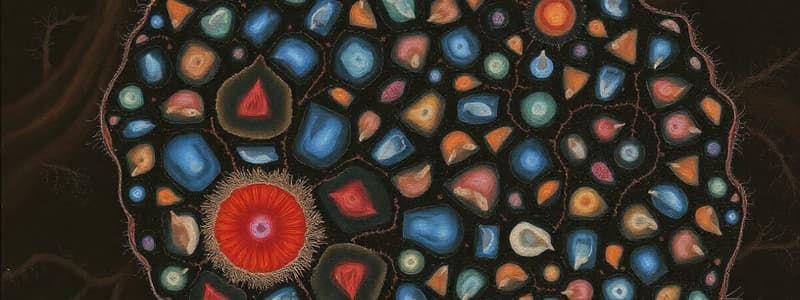Podcast
Questions and Answers
Jakie są cechy wspólne wszystkich komórek?
Jakie są cechy wspólne wszystkich komórek?
- Obecność błony plazmatycznej (correct)
- Obecność organelli błonowych
- Obecność jądra komórkowego
- Obecność chloroplastów
Który proces komórkowy obejmuje wytwarzanie ATP z glukozy?
Który proces komórkowy obejmuje wytwarzanie ATP z glukozy?
- Oddychanie komórkowe (correct)
- Fotosynteza
- Wydalanie
- Mitoza
Co to są mutacje w kontekście dziedziczenia?
Co to są mutacje w kontekście dziedziczenia?
- Wszystkie zmiany w populacji
- Fenotypowe różnice w organizmach
- Zmiany w sekwencji DNA (correct)
- Podziały komórkowe
Jakie znaczenie ma dobór naturalny w procesie ewolucji?
Jakie znaczenie ma dobór naturalny w procesie ewolucji?
Która z opcji najlepiej opisuje rolę ekosystemów?
Która z opcji najlepiej opisuje rolę ekosystemów?
Jakie procesy są analizowane w biologii organizmów?
Jakie procesy są analizowane w biologii organizmów?
Co oznacza pojęcie homoestazy w kontekście organizmów?
Co oznacza pojęcie homoestazy w kontekście organizmów?
Jaką technikę wykorzystuje inżynieria genetyczna do modyfikacji organizmów?
Jaką technikę wykorzystuje inżynieria genetyczna do modyfikacji organizmów?
Jaką rolę w biologii pełni biotechnologia?
Jaką rolę w biologii pełni biotechnologia?
Jakie zastosowanie mają zasady biologiczne w kryminalistyce?
Jakie zastosowanie mają zasady biologiczne w kryminalistyce?
Flashcards
Podstawowa jednostka życia
Podstawowa jednostka życia
Komórka to fundamentalna jednostka życia, charakteryzująca się różnorodnymi kształtami i rozmiarami dostosowanymi do ich specyficznych funkcji.
Oddychanie komórkowe
Oddychanie komórkowe
Kluczowy proces metaboliczny, w którym energia jest uwalniana z glukozy, przekształcając ją w ATP (adenozynotrifosforan), główne źródło energii komórki.
Replikacja DNA
Replikacja DNA
Proces kopiowania DNA, kluczowy dla dziedziczenia cech genetycznych.
Dobór naturalny
Dobór naturalny
Signup and view all the flashcards
Ekosystem
Ekosystem
Signup and view all the flashcards
Dynamika populacji
Dynamika populacji
Signup and view all the flashcards
Biotechnologie
Biotechnologie
Signup and view all the flashcards
Różnorodność biologiczna
Różnorodność biologiczna
Signup and view all the flashcards
Inżynieria genetyczna
Inżynieria genetyczna
Signup and view all the flashcards
Homeostaza
Homeostaza
Signup and view all the flashcards
Study Notes
Cell Structure and Function
- Cells are the fundamental units of life, exhibiting a diverse range of shapes and sizes, adapted to their specific functions.
- All cells share basic features like a plasma membrane, cytoplasm, and genetic material (DNA).
- Prokaryotic cells, like bacteria, lack a nucleus and membrane-bound organelles, while eukaryotic cells, including animal and plant cells, possess a nucleus and various organelles.
- The plasma membrane regulates the passage of substances into and out of the cell, maintaining homeostasis.
- Cytoplasm is a jelly-like substance filling the cell, containing various organelles.
Cellular Processes
- Metabolism encompasses all chemical reactions occurring within a cell.
- Cellular respiration is a key metabolic process where energy is released from glucose, converting it into ATP (adenosine triphosphate), the cell's primary energy currency.
- Photosynthesis, unique to plants and some bacteria, utilizes light energy to convert carbon dioxide and water into glucose.
- Cell division, mitosis and meiosis, are essential for growth, development, and repair.
- Mitosis creates two genetically identical daughter cells, crucial for tissue repair and growth.
- Meiosis produces four genetically unique daughter cells, critical for sexual reproduction.
Genetics
- DNA, the molecule of heredity, carries the instructions for building and maintaining an organism.
- Genes are segments of DNA that code for specific proteins, determining traits.
- Mutations are changes in DNA sequences, which can be harmful, beneficial, or neutral.
- Genetic variations provide the raw material for evolution through natural selection.
Evolutionary Biology
- Evolution is the gradual change in the heritable characteristics of biological populations over successive generations.
- Natural selection is a key mechanism of evolution, where traits that enhance survival and reproduction become more common in a population.
- Adaptations are traits that enhance an organism's ability to survive and reproduce in a specific environment.
- Common ancestry links all forms of life, with shared evolutionary history evidenced by homologous structures and genetic similarities.
Ecology
- Ecology studies the relationships between organisms and their environment.
- Ecosystems comprise living organisms and their non-living surroundings, interacting in complex ways.
- Food chains and food webs depict energy flow between organisms.
- Population dynamics investigate factors influencing a population's size and distribution.
- Biodiversity encompasses the variety of life at all levels, including genes, species, and ecosystems.
Organismal Biology
- Plant biology explores plant structures, functions, and adaptations.
- Animal biology examines animal structures, functions, and behaviors, considering diverse physiological processes and evolutionary adaptations.
- Organ systems in animals contribute to specific functions, like digestion, respiration, and circulation.
- Homeostasis is the maintenance of a stable internal environment despite external changes.
Biotechnology
- Biotechnology utilizes biological systems and organisms to develop or make products, such as drugs, enzymes, and food.
- Genetic engineering alters an organism's genetic material through tools like CRISPR, to modify traits.
- Cloning produces genetically similar copies of an organism.
- Recombinant DNA technology combines DNA from different sources.
Biological Applications
- Biology underlies medical advancements, such as disease treatments and diagnostics.
- Agricultural practices improve food production through genetic modification and sustainable farming.
- Conservation biology protects biodiversity and endangered species.
- Forensic biology employs biological principles in criminal investigations, like DNA analysis.
Studying That Suits You
Use AI to generate personalized quizzes and flashcards to suit your learning preferences.
Description
Ten quiz sprawdzi Twoją wiedzę na temat struktury i funkcji komórek. Dowiesz się o różnicach między komórkami prokariotycznymi a eukariotycznymi oraz procesach komórkowych, takich jak metabolizm i fotosynteza. Sprawdź, jak komórki utrzymują równowagę i przetwarzają energię!




